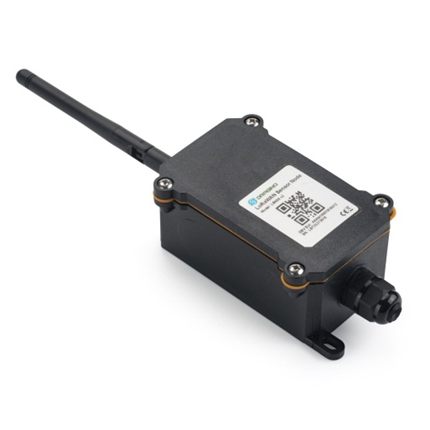
Table of Contents:
1. Introduction
1.1 What is LoRaWAN Soil Moisture & EC Sensor
NBSN95 is a Long Range NB-IoT Sensor Node. It is designed for outdoor data logging and powered by Li/SOCl2 battery for long term use and secure data transmission. It is designed to facilitate developers to quickly deploy industrial level NB-IoT solutions. It helps users to turn the idea into a practical application and make the Internet of Things a reality. It is easy to program, create and connect your things everywhere.
NarrowBand-Internet of Things (NB-IoT) is a standards-based low power wide area (LPWA) technology developed to enable a wide range of new IoT devices and services. NB-IoT significantly improves the power consumption of user devices, system capacity and spectrum efficiency, especially in deep coverage.
NBSN95 uses STM32l0x chip from ST, STML0x is the ultra-low-power STM32L072xx microcontrollers incorporate the connectivity power of the universal serial bus (USB 2.0 crystal-less) with the high-performance ARM® Cortex®-M0+ 32-bit RISC core operating at a 32 MHz frequency, a memory protection unit (MPU), high-speed embedded memories (192 Kbytes of Flash program memory, 6 Kbytes of data EEPROM and 20 Kbytes of RAM) plus an extensive range of enhanced I/Os and peripherals.
NBSN95 is an open source product, it is based on the STM32Cube HAL drivers and lots of libraries can be found in ST site for rapid development.

1.2 Features
- STM32L072CZT6 MCU
- NB-IoT Bands: B1/B3/B8/B5/B20/B28 @H-FDD
- Pre-load bootloader on USART1/USART2
- MDK-ARM Version 5.24a IDE
- I2C, LPUSART1, USB, SPI2
- 3x12bit ADC, 1x12bit DAC
- 20xDigital I/O
- Open-source hardware / software
- IP66 Waterproof Enclosure
- Ultra-Low Power consumption
- AT Commands to change parameters
- Micro SIM card slot for NB-IoT SIM
- 8500mAh Battery for long term use
1.3 Specification
Micro Controller:
- STM32L072CZT6 MCU
- MCU: STM32L072CZT6
- Flash: 192KB
- RAM: 20KB
- EEPROM: 6KB
- Clock Speed: 32Mhz
Common DC Characteristics:
- Supply Voltage: 2.1v ~ 3.6v
- Operating Temperature: -40 ~ 85°C
- I/O pins: Refer to STM32L072 datasheet
NB-IoT Spec:
- - B1 @H-FDD: 2100MHz
- - B3 @H-FDD: 1800MHz
- - B8 @H-FDD: 900MHz
- - B5 @H-FDD: 850MHz
- - B20 @H-FDD: 800MHz
- - B28 @H-FDD: 700MHz
Battery:
- Li/SOCI2 un-chargeable battery
- Capacity: 8500mAh
- Self Discharge: <1% / Year @ 25°C
- Max continuously current: 130mA
- Max boost current: 2A, 1 second
Power Consumption
- STOP Mode: 10uA @ 3.3v
- Max transmit power: 350mA@3.3v
1.4 Applications
- Smart Buildings & Home Automation
- Logistics and Supply Chain Management
- Smart Metering
- Smart Agriculture
- Smart Cities
- Smart Factory
1.5 Pin Definitions & Switch
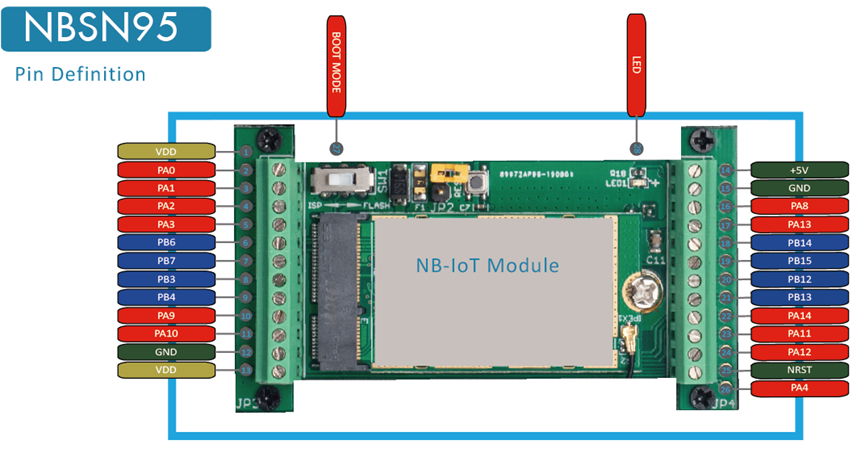
| No. | Signal | Direction | Function | Remark |
|---|---|---|---|---|
| 1 | VCC(2.9V) | OUTPUT | VCC | Directly connect to main power for board |
| 2 | PA0 | In/Out | Directly from STM32 chip | Used as ADC in NBSN95 image |
| 3 | PA1 | In/Out | Directly from STM32 chip | |
| 4 | PA2 | In/Out | Directly from STM32 chip, 10k pull up to VCC | Used as UART_TXD in NBSN95 image |
| 5 | PA3 | In/Out | Directly from STM32 chip, 10k pull up to VCC | Used as UART_RXD in NBSN95 image |
| 6 | PB6 | In/Out | Directly from STM32 chip, 10k pull up to VCC | |
| 7 | PB7 | In/Out | Directly from STM32 chip, 10k pull up to VCC | |
| 8 | PB3 | In/Out | Directly from STM32 chip, 10k pull up to VCC | |
| 9 | PB4 | In/Out | Directly from STM32 chip | |
| 10 | PA9 | In/Out | Directly from STM32 chip, 10k pull up to VCC | |
| 11 | PA10 | In/Out | Directly from STM32 chip, 10k pull up to VCC | |
| 12 | GND | Ground | ||
| 13 | VCC(2.9V) | OUTPUT | VCC | Directly connect to main power for board |
| 14 | Jumper | Power on/off jumper | ||
| 15 | PA4 | In/Out | Directly from STM32 chip | |
| 16 | NRST | In | Reset MCU | |
| 17 | PA12 | In/Out | Directly from STM32 chip | |
| 18 | PA11 | In/Out | Directly from STM32 chip | |
| 19 | PA14 | In/Out | Directly from STM32 chip | |
| 20 | PB13 | In/Out | Directly from STM32 chip | |
| 21 | PB12 | In/Out | Directly from STM32 chip | |
| 22 | PB15 | In/Out | Directly from STM32 chip | |
| 23 | PB14 | In/Out | Directly from STM32 chip | |
| 24 | PA13 | In/Out | Directly from STM32 chip | |
| 25 | PA8 | In/Out | Directly from STM32 chip | Default use to turn on/off LED1 in NBSN95 image |
| 26 | GND | Ground | ||
| 27 | +5V | Out | 5v output power | Controlled by PB5(Low to Enable, High to Disable) |
| 28 | LED1 | Controlled by PA8 | Blink on transmit | |
| 29 | BOOT MODE | Configure device in working mode or ISP program mode | Flash: Normal Working mode and send AT Commands ISP: UART Program Mode | |
| 30 | NRST | In | Reset MCU |
1.5.1 Jumper JP2
Power on Device when put this jumper.
1.5.2 BOOT MODE / SW1
1) ISP: upgrade mode, device won't have any signal in this mode. but ready for upgrade firmware. LED won't work. Firmware won't run.
2) Flash: work mode, device starts to work and send out console output for further debug
1.5.3 Reset Button
Press to reboot the device.
1.5.4 LED
It will flash:
- When boot the device in flash mode
- Send an uplink packet
1.6 Hole Option
The NBSN95 provides different hole size options for different size sensor cable. The options provided are M12, M16. The definition is as below:
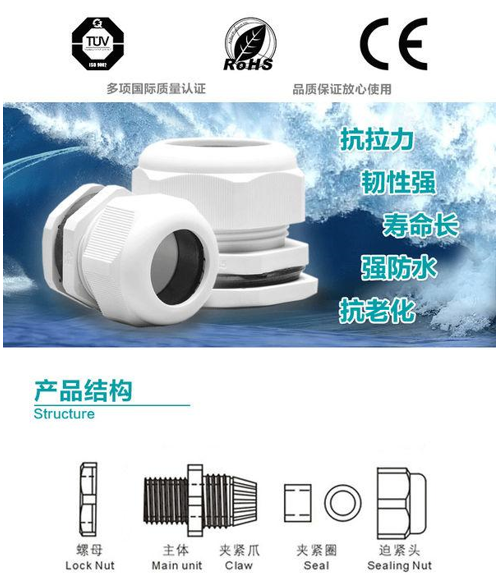
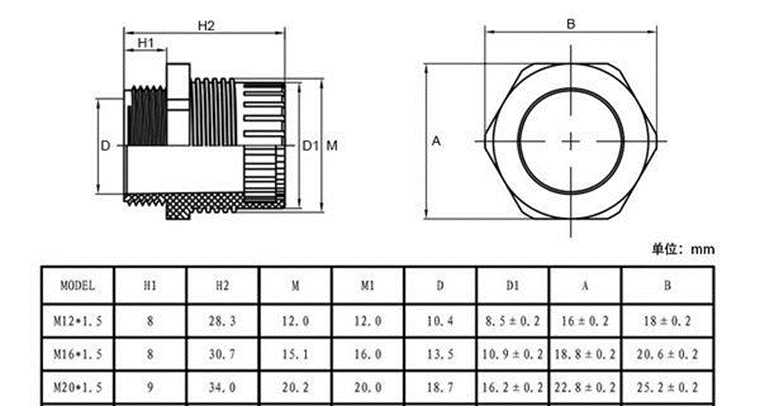
2. Use NBSN95 to communicate with IoT Server
2.1 How it works
The NBSN95 is equipped with a NB-IoT module, the pre-loaded firmware in NBSN95 will get environment data from sensors and send the value to local NB-IoT network via the NB-IoT module. The NB-IoT network will forward this value to IoT server via the protocol defined by NBSN95.
The diagram below shows the working flow in default firmware of NBSN95:
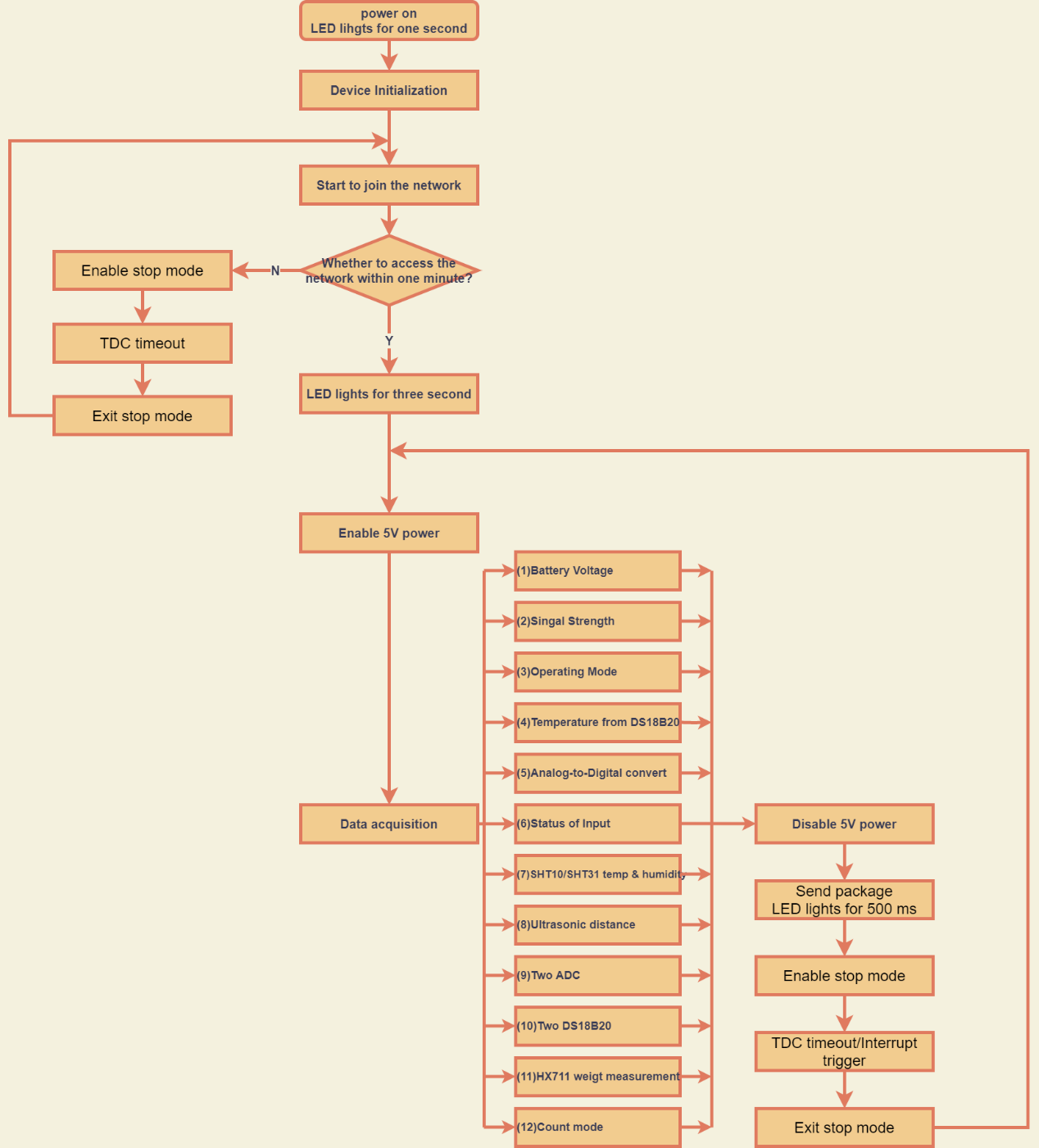
2.2 Configure the NBSN95
2.2.1 Power On NBSN95
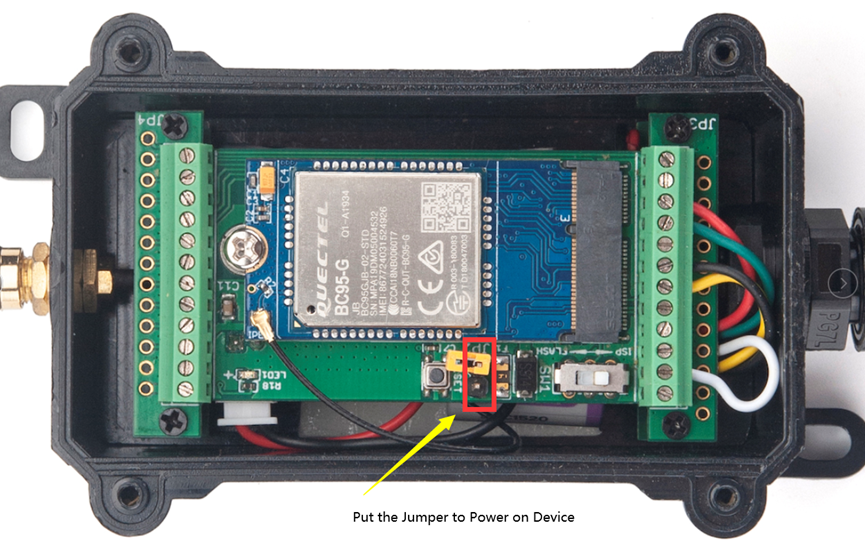
2.2.2 Test Requirement
To use NBSN95 in your city, make sure meet below requirements:
- Your local operator has already distributed a NB-IoT Network there.
- The local NB-IoT network used the band that NBSN95 supports.
- Your operator is able to distribute the data received in their NB-IoT network to your IoT server.
Below figure shows our testing structure. Here we have NB-IoT network coverage by China Mobile, the band they use is B8. The NBSN95 will use CoAP(120.24.4.116:5683) or raw UDP(120.24.4.116:5601) or MQTT(120.24.4.116:1883)or TCP(120.24.4.116:5600)protocol to send data to the test server
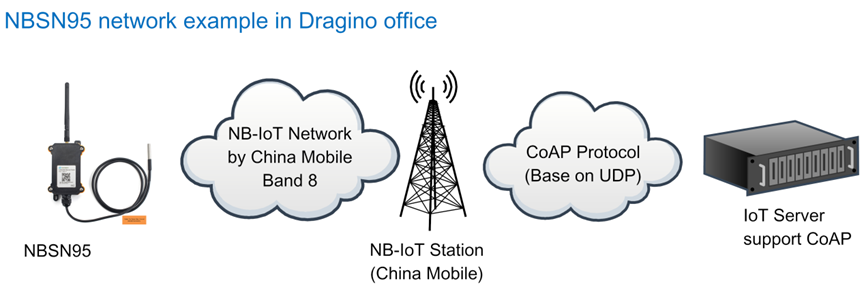
2.2.3 Insert SIM card
Insert the NB-IoT Card get from your provider.
User need to take out the NB-IoT module and insert the SIM card like below:
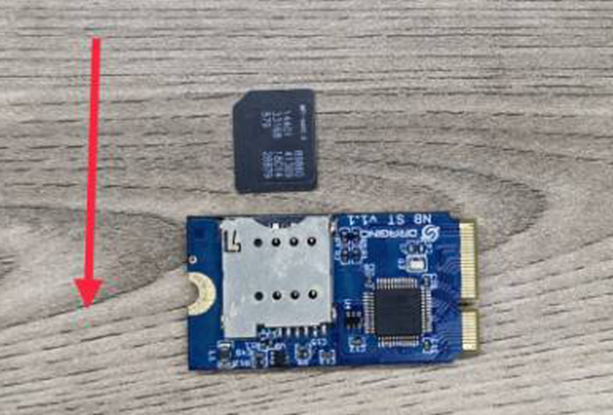
2.2.4 Connect USB – TTL to NBSN95 to configure it
User need to configure NBSN95 via serial port to set the Server Address / Uplink Topic to define where and how-to uplink packets. NBSN95 support AT Commands, user can use a USB to TTL adapter to connect to NBSN95 and use AT Commands to configure it, as below.
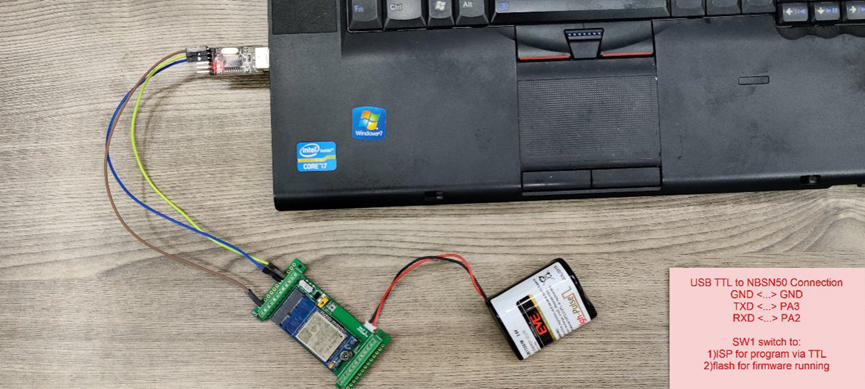
In the PC, use below serial tool settings:
- Baud: 9600
- Data bits: 8
- Stop bits: 1
- Parity: None
- Flow Control: None
Make sure the switch is in FLASH position, then power on device by connecting the jumper on NBSN95. NBSN95 will output system info once power on as below, we can enter the password: 12345678 to access AT Command input.
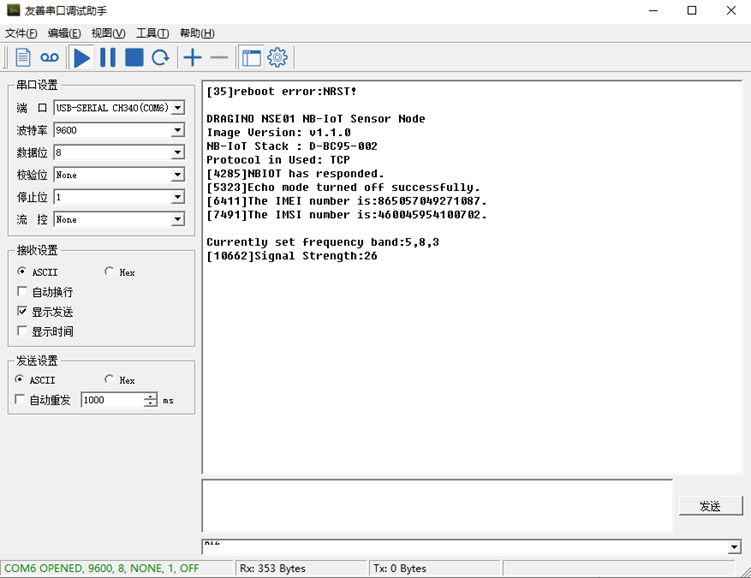
Note: the valid AT Commands can be found at: https://www.dragino.com/downloads/index.php?dir=NB-IoT/NBSN95/
2.2.5 Use CoAP protocol to uplink data
Note: if you don't have CoAP server, you can refer this link to set up one: http://wiki.dragino.com/xwiki/bin/view/Main/Set%20up%20CoAP%20Server/
Use below commands:
- AT+PRO=1 // Set to use CoAP protocol to uplink
- AT+SERVADDR=120.24.4.116,5683 // to set CoAP server address and port
- AT+URI=5,11,"mqtt",11,"coap",12,"0",15,"c=text1",23,"0" //Set COAP resource path
For parameter description, please refer to AT command set
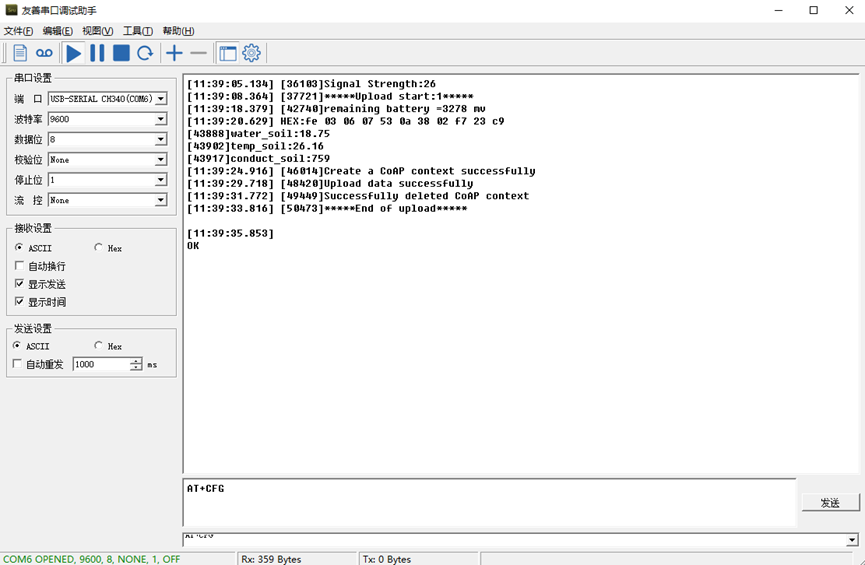
After configure the server address and reset the device (via AT+ATZ ), NSE01 will start to uplink sensor values to CoAP server.
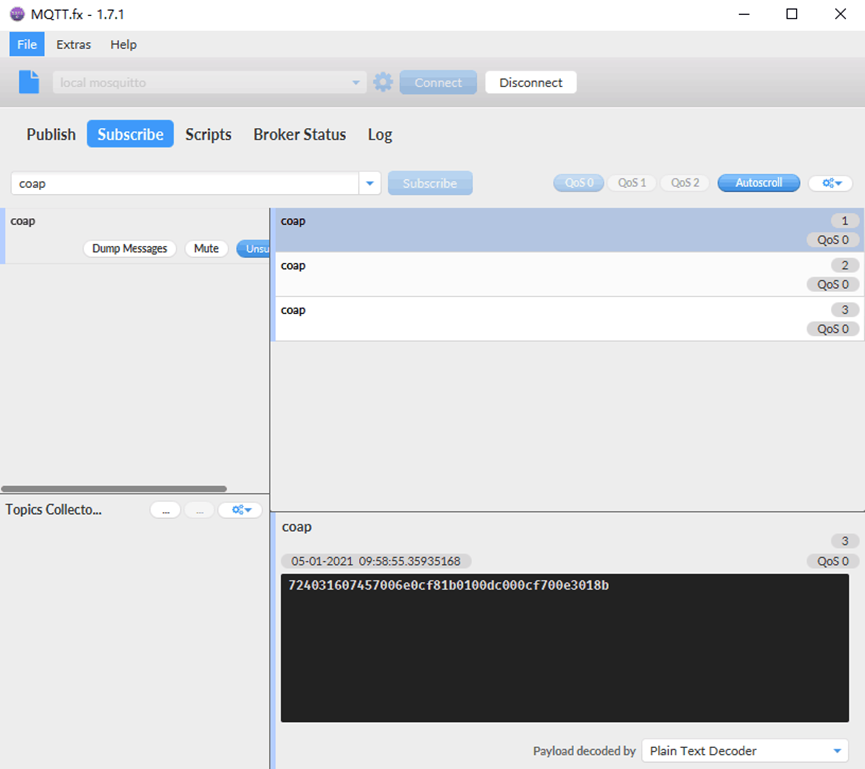
2.2.6 Use UDP protocol to uplink data(Default protocol)
This feature is supported since firmware version v1.0.1
- AT+PRO=2 // Set to use UDP protocol to uplink
- AT+SERVADDR=120.24.4.116,5601 // to set UDP server address and port
- AT+CFM=1 //If the server does not respond, this command is unnecessary
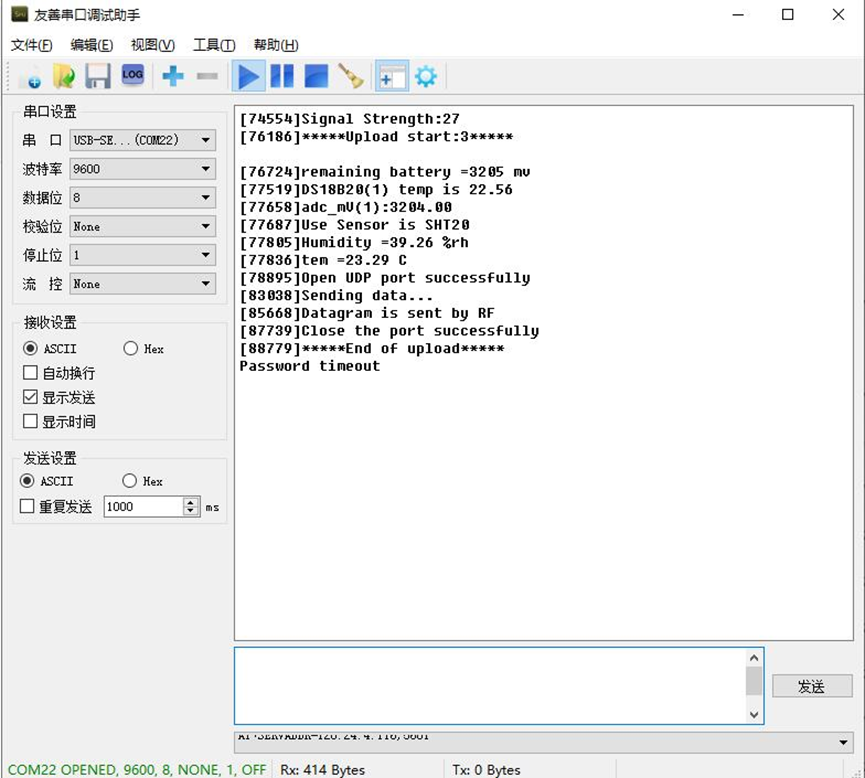
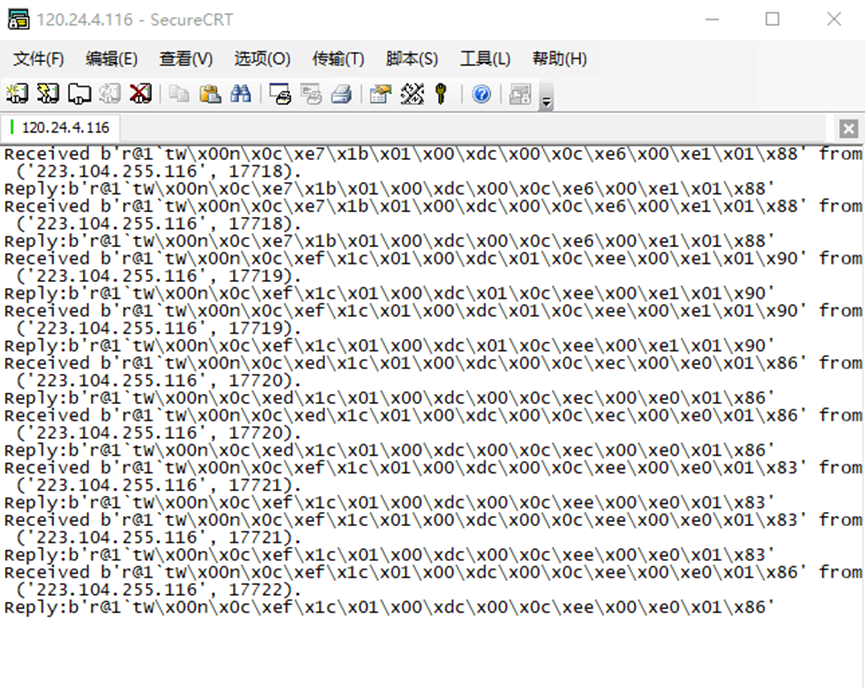
2.2.7 Use MQTT protocol to uplink data
This feature is supported since firmware version v110, it supports only plain MQTT now it doesn't support TLS and other related encryption.
- AT+PRO=3 //Set to use MQTT protocol to uplink
- AT+SERVADDR=120.24.4.116,1883 //Set MQTT server address and port
- AT+CLIENT=CLIENT //Set up the CLIENT of MQTT
- AT+UNAME=UNAME //Set the username of MQTT
- AT+PWD=PWD //Set the password of MQTT
- AT+PUBTOPIC=T1_PUB //Set the sending topic of MQTT
- AT+SUBTOPIC=T1_SUB //Set the subscription topic of MQTT
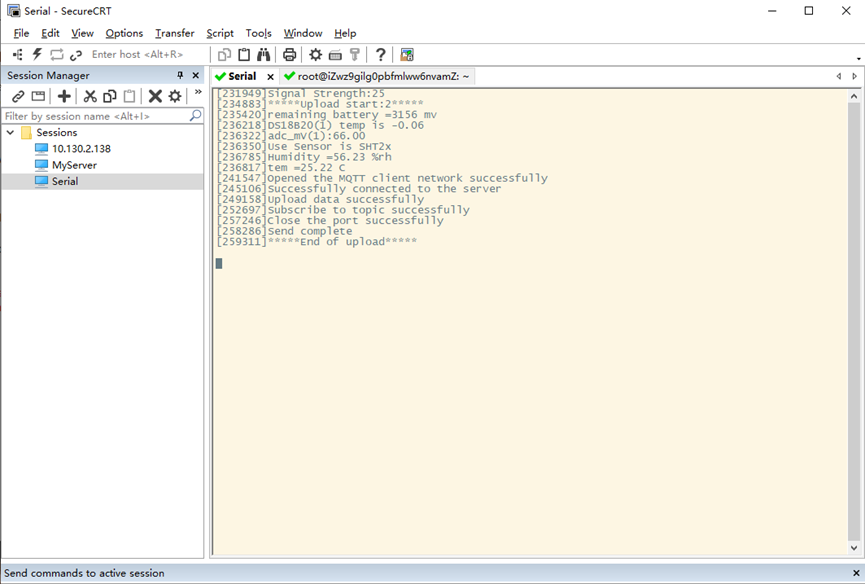
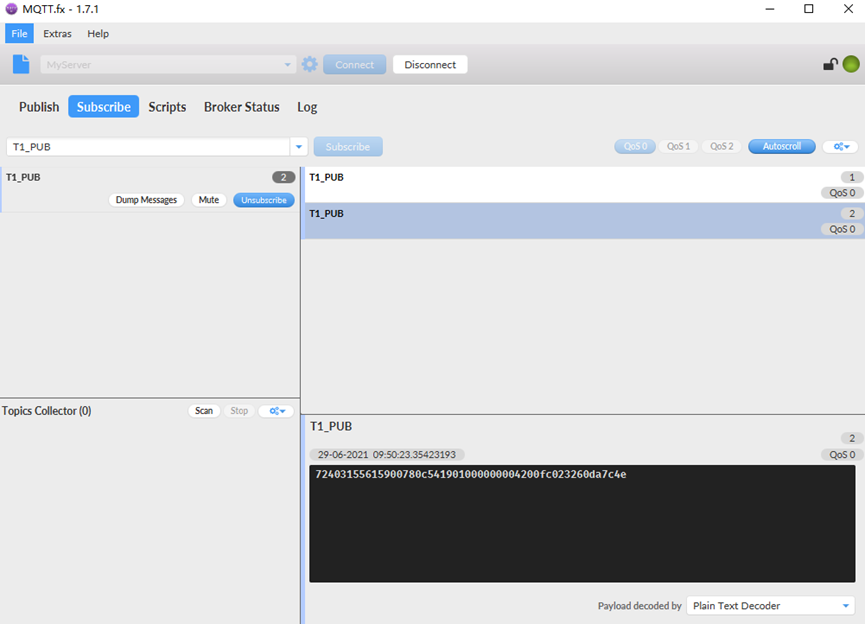
To save battery life, NBSN95 will establish a subscription before each uplink and close the subscription 3 seconds after uplink successful. Any downlink commands from server will only arrive during the subscription period.
MQTT protocol has a much higher power consumption compare vs UDP / CoAP protocol. Please check the power analyze document and adjust the uplink period to a suitable interval.
2.2.8 Use TCP protocol to uplink data
This feature is supported since firmware version v110
- AT+PRO=4 // Set to use TCP protocol to uplink
- AT+SERVADDR=120.24.4.116,5600 // to set TCP server address and port
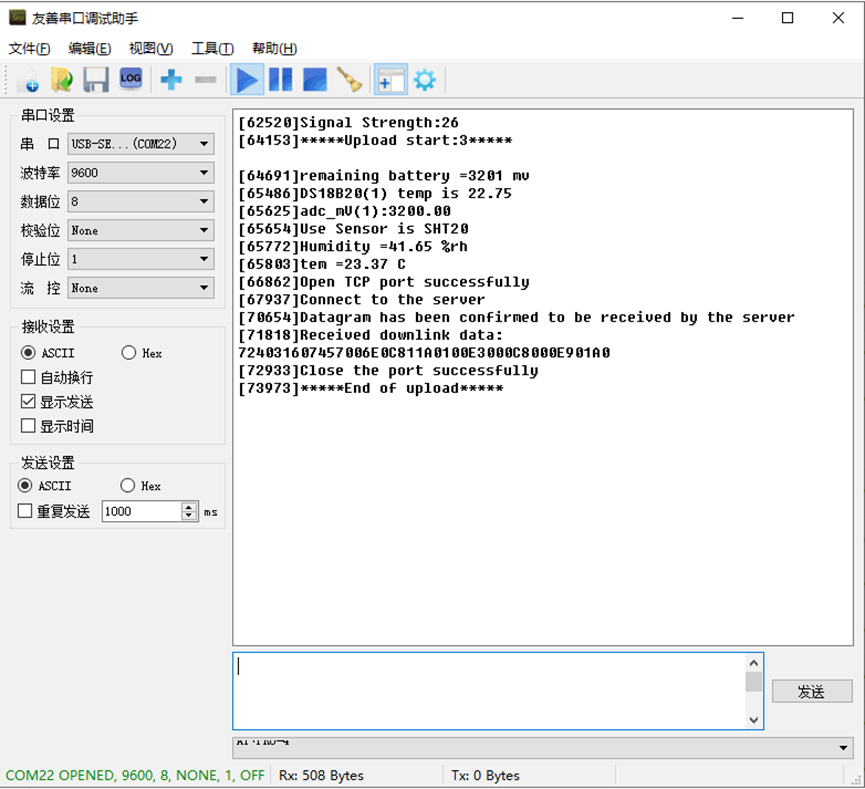
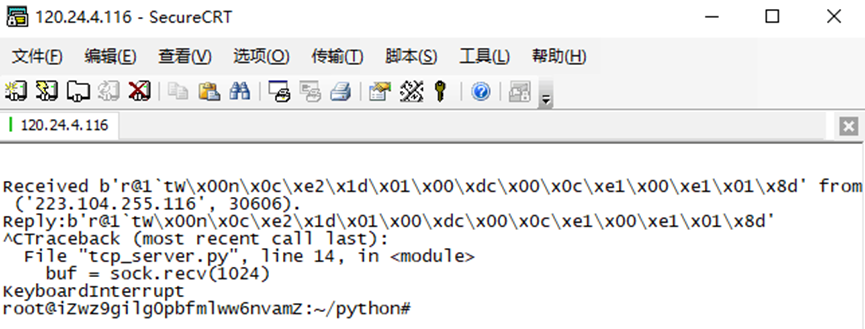
2.2.9 Change Update Interval
User can use below command to change the uplink interval.
- AT+TDC=600 // Set Update Interval to 600s
2.3 Working Mode & Uplink Payload
NBSN95 has different working mode for the connections of different type of sensors. This section describes these modes. User can use the AT Command AT+CFGMOD to set NBSN95 to different working modes.
For example:
AT+CFGMOD=2 // will set the NBSN95 to work in MOD=2 distance mode which target to measure distance via Ultrasonic Sensor.
The uplink payloads are composed in ASCII String. For example:
0a cd 00 ed 0a cc 00 00 ef 02 d2 1d (total 24 ASCII Chars). Representative the actually payload:
0x 0a cd 00 ed 0a cc 00 00 ef 02 d2 1d Total 12 bytes
NOTE:
1. All modes share the same Payload Explanation from HERE.
2. By default, the device will send an uplink message every 1 hour.
2.3.1 CFGMOD=1 (Default Mode)
In this mode, the uplink payload usually contains 25 bytes. (Note: Time stamp field are added since firmware version v120)
Size (bytes) | 6 | 2
| 2 | 1 | 1 | 2 | 1 | 2 | 2 | 2 | 4 |
| Value | Device ID | Ver | BAT | Signal Strength | MOD 0x01 | Digital in & Interrupt | ADC | Timestamp |
If the cache upload mechanism is turned on, you will receive the payload shown in the figure below.
| Frame header | Frame data (1) | Frame data (2) | F… | Frame data(X) |
NOTE:
1. Only up to 10 sets of latest data will be cached.
2. Theoretically, the maximum upload bytes are 215.
If we use the MQTT client to subscribe to this MQTT topic, we can see the following information when the NB sensor uplink data.
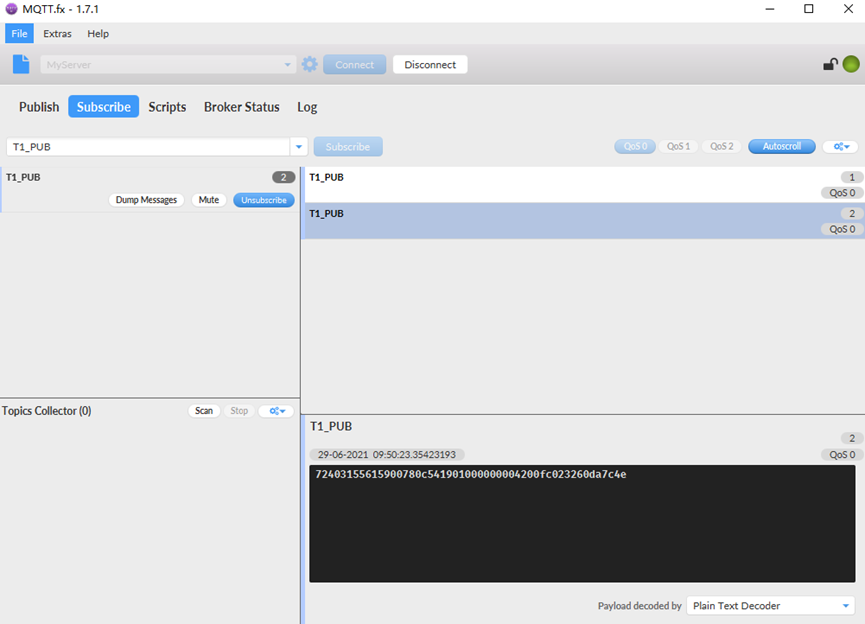
The payload is ASCII string, representative same HEX: 0x72403155615900780c541901000000004200fc023260da7c4e where:
- Device ID: 0x724031556159 = 724031556159
- Version: 0x0078=120=1.2.0
- BAT: 0x0c54 = 3156 mV = 3.156V
- Singal: 0x19 = 25
- Model: 0x01 = 1
- Temperature by DS18b20: 0x0000 = 0
- Interrupt: 0x00 = 0
- ADC: 0x0042 = 66 = 66mv
- Temperature by SHT20/SHT31: 0x00fc = 252 = 25.2 °C
- Humidity by SHT20/SHT31: 0x0232 = 562 = 56.2 %rh
- Timestamp: 0x60da7c4e = 1,624,931,406 = 2021-06-29 09:50:06
2.3.2 CFGMOD=2 (Distance Mode)
This mode is target to measure the distance. Total 23 bytes, (Note: Time stamp field are added since firmware version v120)
| Size (bytes) | 6 | 2 | 2 | 1 | 1 | 2 | 1 | 2 | 2 | 4 |
|---|---|---|---|---|---|---|---|---|---|---|
| Value | Device ID | Ver | BAT | Signal Strength | MOD 0x02 | ADC | Timestamp |
If the cache upload mechanism is turned on, you will receive the payload shown in the figure below.
| Frame header | Frame data(1) | Frame data(2) | F… | Frame data(X) |
NOTE:
1. Only up to 10 sets of latest data will be cached.
2. Theoretically, the maximum upload bytes are 193.
If we use the MQTT client to subscribe to this MQTT topic, we can see the following information when the NB sensor uplink data.
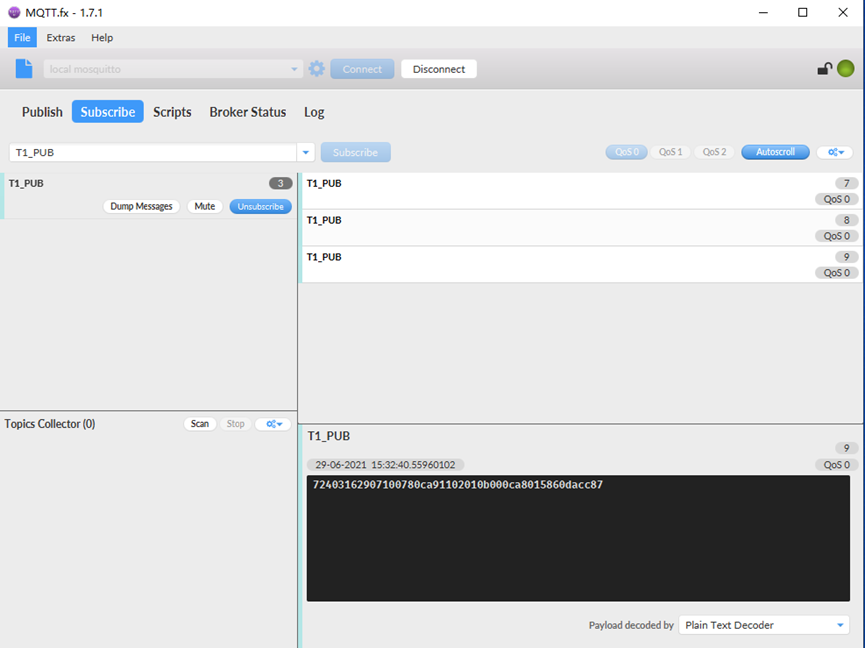
So the payload is 0x72403162907100780ca91102010b000ca8015860dacc87 where:
- Device ID: 0x724031629071 = 724031629071
- Version: 0x0078=120=1.2.0
- BAT: 0x0ca9 = 3241mV = 3.241 V
- Singal: 0x11 = 17
- Model: 0x02 = 2
- Temperature by DS18b20: 0x010b= 267 = 26.7 °C
- Interrupt: 0x00 = 0
- ADC: 0x0ca8 = 3240 mv
- Distance by LIDAR-Lite V3HP/Ultrasonic Sensor: 0x0158 = 344 cm
- Timestamp: 0x60dacc87 = 1,624,951,943 = 2021-06-29 15:32:23
Connection of LIDAR-Lite V3HP:
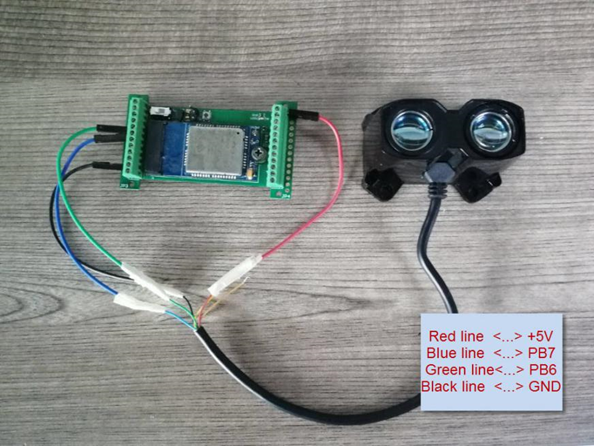
Connection to Ultrasonic Sensor:
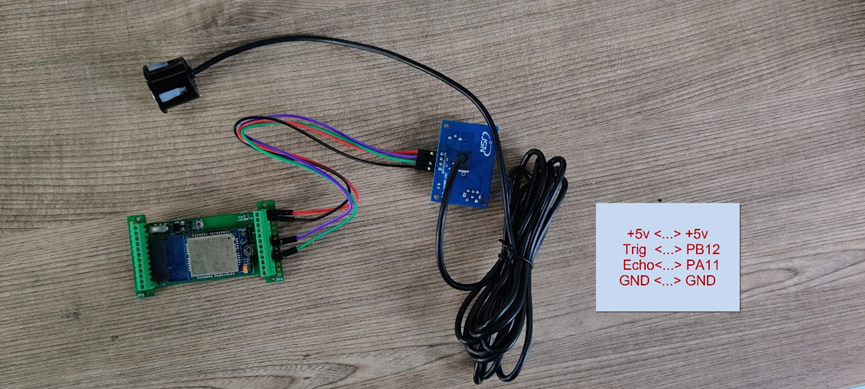
2.3.3 CFGMOD=3 (3 ADC + I2C)
This mode has total 26 bytes. Include 3 x ADC + 1x I2C, (Note: Time stamp field are added since firmware version v120)
Size (bytes) | 6 | 1 | 2 | 1 | 1 | 2 | 1 | 2 | 2 | 2 | 2 | 4 |
|---|---|---|---|---|---|---|---|---|---|---|---|---|
| Value | Device ID | BAT | Signal Strength | MOD 0x03 | ADC1
| Digital in & Interrupt | ADC2
| ADC3
| Timestamp |
ADC1 uses pin PA0 to measure
ADC2 uses pin PA1 to measure
ADC3 uses pin PA4 to measure
If the cache upload mechanism is turned on, you will receive the payload shown in the figure below.
| Frame header | Frame data(1) | Frame data(2) | F… | Frame data(X) |
NOTE:
1. Only up to 10 sets of latest data will be cached.
2. Theoretically, the maximum upload bytes are 226.
If we use the MQTT client to subscribe to this MQTT topic, we can see the following information when the NB sensor uplink data.
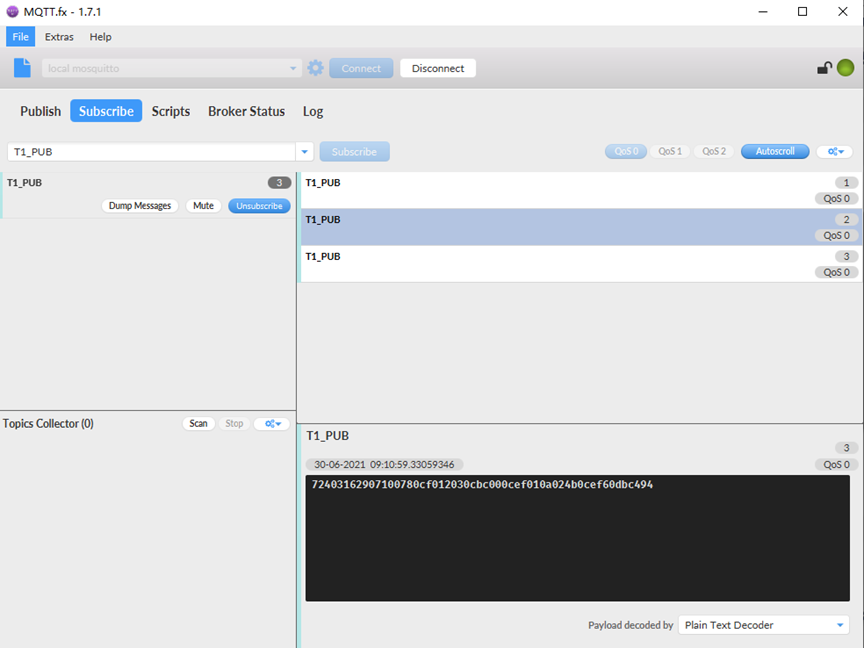
So the payload is 0x724031629071780cf012030cbc000cef010a024b0cef60dbc494 where:
- Device ID: 0x724031629071 = 724031629071
- Version: 0x78=120=1.2.0
- BAT: 0x0cf0 = 3312 mV = 3.312 V
- Singal: 0x12 = 18
- Model: 0x03 = 3
- ADC1: 0x0cbc= 3260mV
- Interrupt: 0x00 = 0
- ADC2: 0x0cef =3311 mv
- Temperature by SHT20/SHT31: 0x010a = 266 = 26.6 °C
- Humidity by SHT20/SHT31: 0x024b =587 = 58.7 %rh
- ADC2: 0x0cef = 3311 mv
- Timestamp: 0x60dbc494 = 1,625,015,444= 2021-06-30 09:10:44
2.3.4 CFGMOD=4 (3 x DS18B20)
Hardware connection is as below, (Note: R3 & R4 should change from 10k to 4.7k to support DS18B20, Software set to AT+CFGMOD=4)
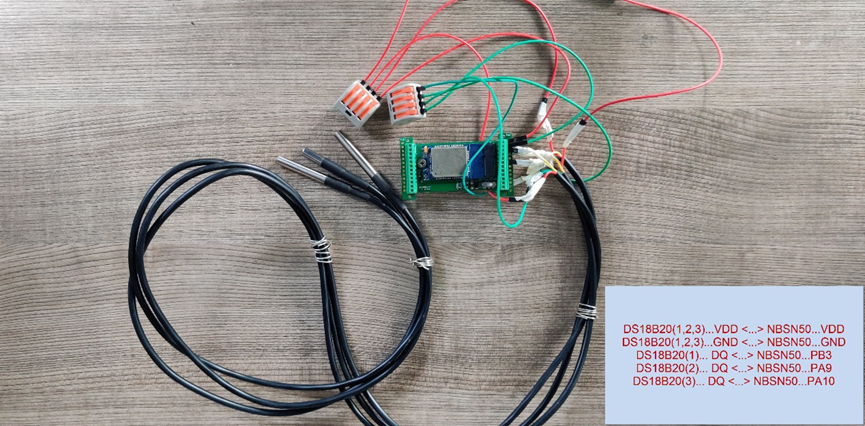
This mode has total 25 bytes. (Note: Time stamp field are added since firmware version v120) As shown below:
Size(bytes) | 6 | 2 | 2 | 1 | 1 | 2 | 2 | 1 | 2 | 2 | 4 |
|---|---|---|---|---|---|---|---|---|---|---|---|
| Value | Device ID | Ver | BAT | Signal strength | MOD (0x04) | Digital in & Digital Interrupt | Timestamp |
If the cache upload mechanism is turned on, you will receive the payload shown in the figure below.
| Frame header | FFrame data(1) | FFrame data(2) | F… | FFrame data(X) |
NOTE:
1. Only up to 10 sets of latest data will be cached.
2. Theoretically, the maximum upload bytes is 215.
If we use the MQTT client to subscribe to this MQTT topic, we can see the following information when the NB sensor uplink data.
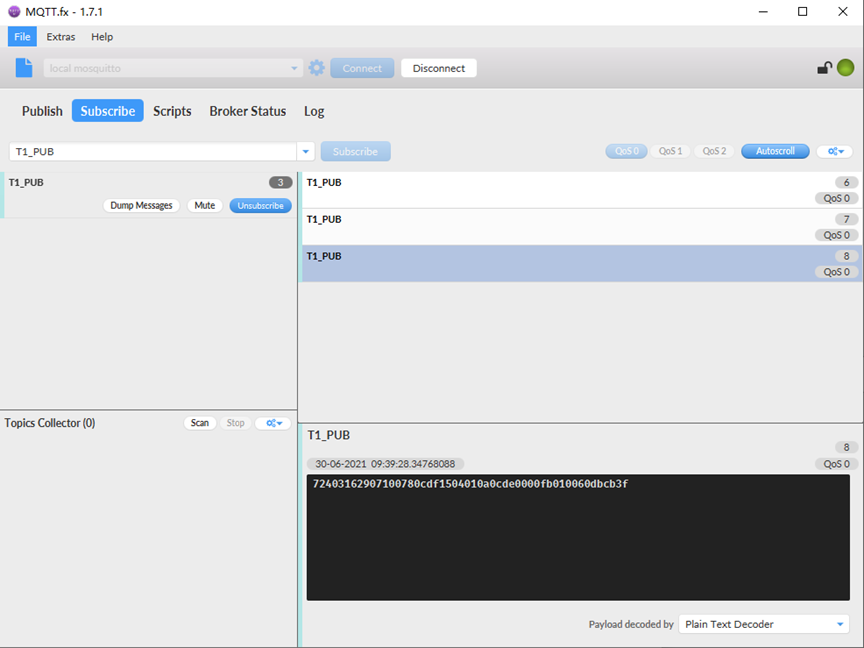
So the payload is 0x72403162907100780cdf1504010a0cde0000fb010060dbcb3f where:
- Device ID: 0x724031629071 = 724031629071
- Version: 0x0078=120=1.2.0
- BAT: 0x0cdf = 3295 mV = 3.295 V
- Singal: 0x15 = 21
- Model: 0x04 = 4
- Temperature by DS18b20: 0x010a = 226 = 22.6 °C
- ADC: 0x0cde = 3294 mv
- Interrupt: 0x00 = 0
- Temperature by DS18b20: 0x00fb = 251 = 25.1°C
- Temperature by DS18b20: 0x0100 = 256 = 25.6 °C
- Timestamp: 0x60dbcb3f = 1,625,017,151= 2021-06-30 09:39:11
2.3.5 CFGMOD=5 (Weight Measurement by HX711)
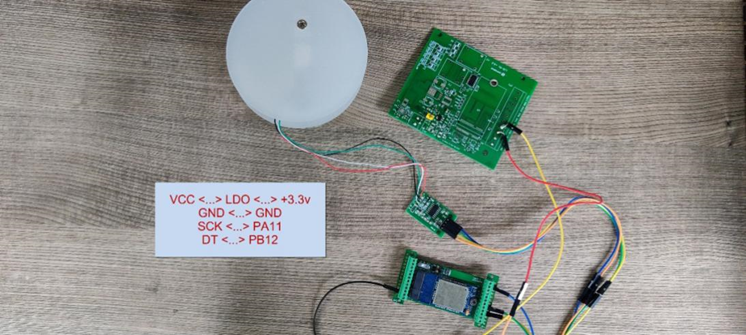
Notes about hardware connection:
- Don't connect the HX711 module VCC to NBSN95 3.3v VCC, in this case, the NBSN95 will always power on HX711 and the battery will run out soon.
- HX711 support 5v VCC, but while connect the NBSN95's +5V to HX711 VCC, the value from HX711 is not stable.
- Connect NBSN95 +5V to HX711 VCC via a LDO module is stable.
Each HX711 need to be calibrated before used. User need to do below two steps:
- Zero calibration. Don’t put anything on load cell and run AT+WEIGRE to calibrate to Zero gram.
- Adjust calibration factor (default value 400): Put a known weight thing on load cell and run AT+WEIGAP to adjust the Calibration Factor.
For example:
AT+WEIGAP =403.0
Response: Weight is 401 g
Check the response of this command and adjust the value to match the real value for thing.
This mode has total 23 bytes. (Note: Time stamp field are added since firmware version v120). As shown below:
Size(bytes) | 6 | 2 | 2 | 1 | 1 | 2 | 2 | 1 | 2 | 4 |
|---|---|---|---|---|---|---|---|---|---|---|
| Value | Device ID | BAT | Signal strength | MOD (0x05) | ADC | Digital in & Digital Interrupt | Weight | Timestamp |
If the cache upload mechanism is turned on, you will receive the payload shown in the figure below.
| Frame header | Frame data (1) | Frame data (2) | F… | Frame data(X) |
NOTE:
1. Only up to 10 sets of latest data will be cached.
2. Theoretically, the maximum upload bytes are 193.
If we use the MQTT client to subscribe to this MQTT topic, we can see the following information when the NB sensor uplink data.
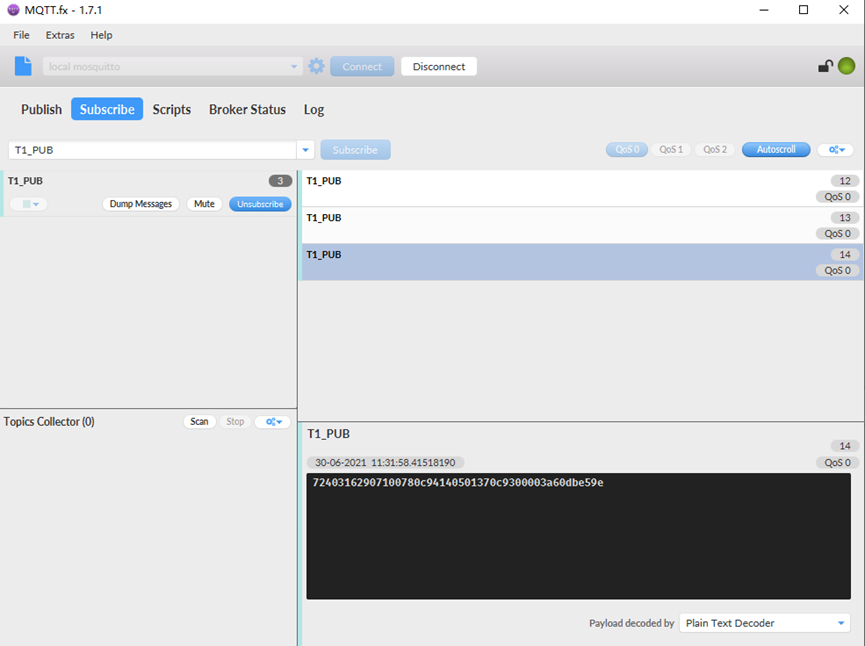
So the payload is 0x72403162907100780c94140501370c9300003a60dbe59e where:
- Device ID: 0x724031629071 =724031629071
- Version: 0x0078=120=1.2.0
- BAT: 0x0c75 = 3220 mV = 3.220 V
- Singal: 0x14 = 20
- Model: 0x05 = 5
- Temperature by DS18b20: 0x0137 = 311 = 31.1 °C
- ADC: 0x0c74 = 3219 mv
- Interrupt: 0x00 = 0
- Weigt by HX711: 0x003a = 58 g
- Timestamp: 0x60dbe59e = 1,625,023,902= 2021-06-30 11:31:42
2.3.6 CFGMOD=6 (Counting mode)
In this mode, uplink payload includes in total 20 bytes, (Note: Time stamp field are added since firmware version v120)
| Size (bytes) | 6 | 2 | 2 | 1 | 1 | 4 | 4 |
|---|---|---|---|---|---|---|---|
| Value | Device ID | Ver | BAT | Signal Strength | MOD 0x06 | Pulse count | Timestamp |
If the cache upload mechanism is turned on, you will receive the payload shown in the figure below.
| Frame header | Frame data (1) | Frame data (2) | F… | Frame data(X) |
NOTE:
1. Only up to 10 sets of latest data will be cached.
2. Theoretically, the maximum upload bytes are 160.
If we use the MQTT client to subscribe to this MQTT topic, we can see the following information when the NB sensor uplink data.
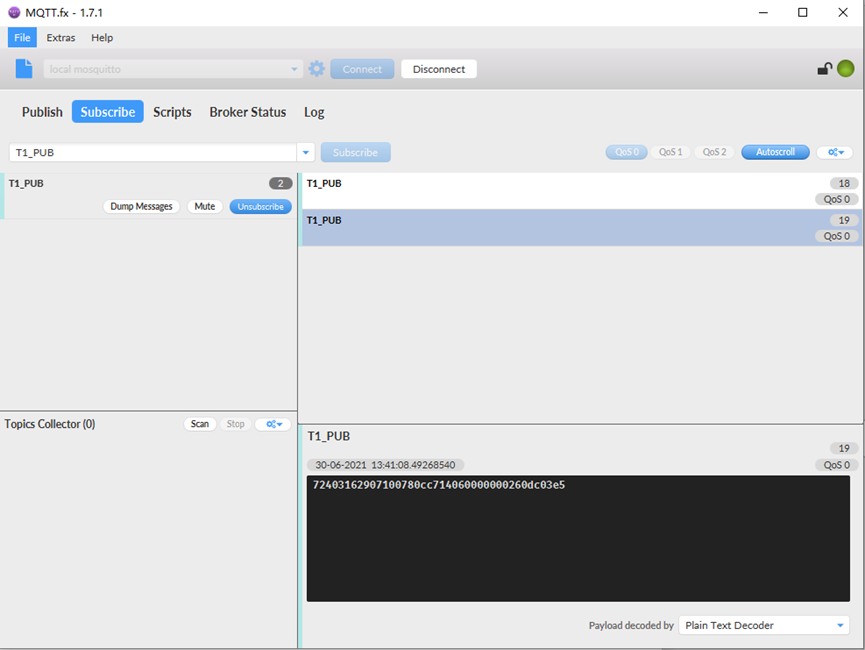
The payload is ASCII string, representative same HEX: 0x72403162907100780cc714060000000260dc03e5 where:
- Device ID: 0x724031629071 = 724031629071
- Version: 0x0078=120=1.2.0
- BAT: 0x0cc7 =3271mV =3.271V
- Singal: 0x14 = 20
- Model: 0x06 = 6
- Pulse count: 0x00000002= 2
- Timestamp: 0x60dc03e5 = 1,625,031,653= 2021-06-30 13:40:53
Size(bytes) | 6 | 2 | 2 | 1 | 2 | 2 | 2 | 1 |
|---|---|---|---|---|---|---|---|---|
| Value | Device ID | Ver | BAT | Signal Strength | Soil Moisture | Soil Temperature | Soil Conductivity(EC) | Interrupt |
2.4 Payload Explanation and Sensor Interface
2.4.1 Device ID
By default, the Device ID equal to the last 6 bytes of IMEI.
User can use AT+DEUI to set Device ID
Example:
AT+DEUI=A84041F15612
The Device ID is stored in a none-erase area, Upgrade the firmware or run AT+FDR won't erase Device ID.
2.4.2 Version Info
These bytes include the hardware and software version.
Higher byte: Specify hardware version: always 0x01 for NBSN95
Lower byte: Specify the software version: 0x6E=110, means firmware version 110
For example: 0x01 6E: this device is NBSN95 with firmware version 110.
2.4.3 Battery Info
Ex1: 0x0B45 = 2885mV
Ex2: 0x0B49 = 2889mV
2.4.4 Signal Strength
NB-IoT Network signal Strength.
Ex1: 0x1d = 29
0 -113dBm or less
1 -111dBm
2...30 -109dBm... -53dBm
31 -51dBm or greater
99 Not known or not detectable
2.4.5 Temperature (DS18B20)
If there is a DS18B20 connected to PB3 pin. The temperature will be uploaded in the payload.
More DS18B20 can check the 3 DS18B20 mode
Connection for one DS18B20
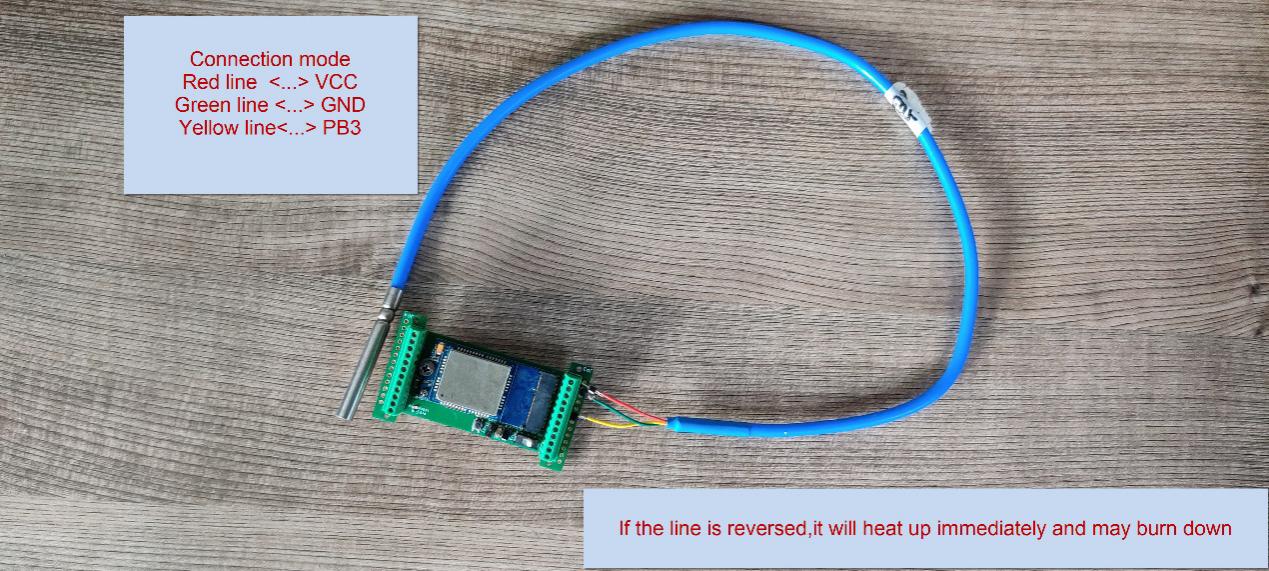
Example:
If payload is: 0x0105: (0105 & FC00 == 0), temp = 0x0105 /10 = 26.1 degree
If payload is: 0xFF3F: (FF3F & FC00 == 1) , temp = (0xFF3F - 65536)/10 = -19.3 degree.
2.4.6 Digital Input
The digital input is for pin PA12,
- When PA12 is high, the bit2 of this byte is 1.
- When PA12 is low, the bit2 of this byte is 0.
2.4.7 Analogue Digital Converter (ADC)
The ADC monitors the voltage on the PA0 line, in mV. Max value is from 0v to BAT voltage
Ex: 0x021F = 543mv,
Example1: Reading a Liquid Level Sensor (Read a resistance value):
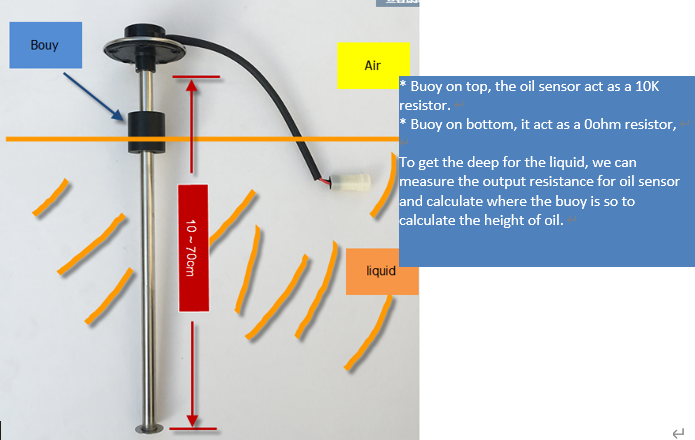
In the NBSN95, we can use PB4 and PA0 pin to calculate the resistance for the liquid level sensor. The bottom of this sensor equal to 0ohm and top position equals to 10kohm.
Steps:
- Solder a 10K resistor between PA0 and VCC.
- Screw liquid level sensor's two pins to PA0 and PB4.
The equipment circuit is as below:
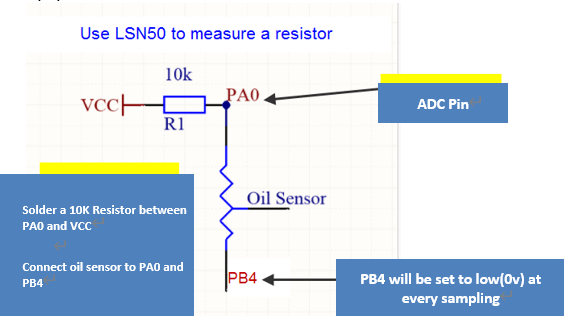
According to above diagram:
(
So

 is the reading of ADC. So if ADC=0x05DC=0.9 v and VCC (BAT) is 2.9v
is the reading of ADC. So if ADC=0x05DC=0.9 v and VCC (BAT) is 2.9v
The  4.5K ohm
4.5K ohm
Since the buoy is linear resistance from 10 ~ 70cm.
The position of buoy is  , from the bottom of buoy
, from the bottom of buoy
2.4.8 Digital Interrupt
Digital Interrupt refers to pin PB14, and there are different trigger methods. When there is a trigger, the NBSN95 will send a packet to the server.
Example to use with door sensor
The door sensor is shown at right. It is a two wire magnetic contact switch used for detecting the open/close status of doors or windows.
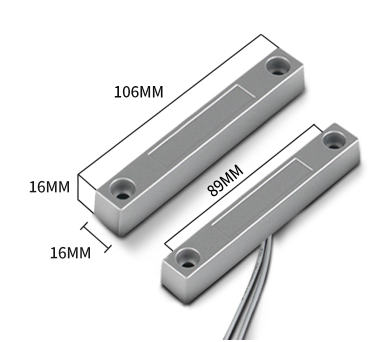
When the two pieces are close to each other, the 2 wire output will be short or open (depending on the type), while if the two pieces are away from each other, the 2 wire output will be the opposite status. So we can use NBSN95 interrupt interface to detect the status for the door or window.
Below is the installation example:
Fix one piece of the magnetic sensor to the door and connect the two pins to NBSN95 as follows:
- One pin to NBSN95's PB14 pin
- The other pin to NBSN95's VCC pin
Install the other piece to the door. Find a place where the two pieces will be close to each other when the door is closed. For this particular magnetic sensor, when the door is closed, the output will be short, and PB14 will be at the VCC voltage.
Door sensors have two types: NC (Normal close) and NO (Normal Open). The connection for both type sensors are the same. But the decoding for payload is reverse, user need to modify this in the IoT Server decoder.
When door sensor is shorted, there will extra power consumption in the circuit, the extra current is 3v3/R14 = 3v2/1Mohm = 0.3uA which can be ignored.
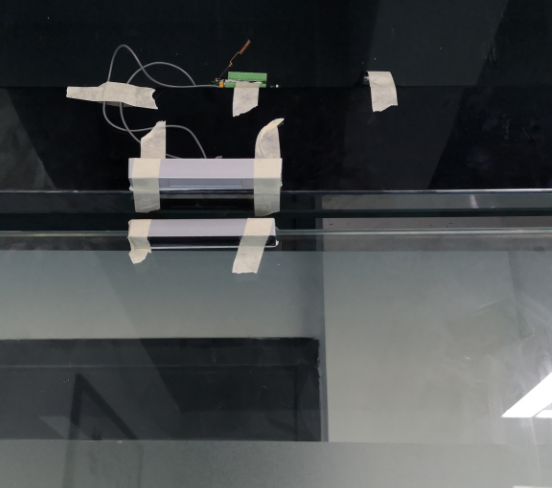
The above photos shows the two parts of the magnetic switch fitted to a door.
The software by default uses the falling edge on the signal line as an interrupt. We need to modify it to accept both the rising edge (0v --> VCC , door close) and the falling edge (VCC --> 0v , door open) as the interrupt.
The command is:
AT+INTMOD=1 //(more info about INMOD please refer AT Command Manual).
Below shows some screen captures in TTN:
In MOD=1, user can use the Digital Input & Interrupt byte to see the status for door open or close. The Decode is:
- When PB14 is high, the bit8 of this byte is 1.
- When PB14 is low, the bit8 of this byte is 0.
2.4.9 I2C Interface (SHT20)
The PB6(SDA) and PB7(SCK) are I2C interface. User can use these pins to connect to an I2C device and get the sensor data.
There is an example to show how to use the I2C interface to connect to the SHT20 Temperature and Humidity Sensor. This is support in AT+CFGMOD=1 (default value).
Hardware connection for SHT20 is as below:
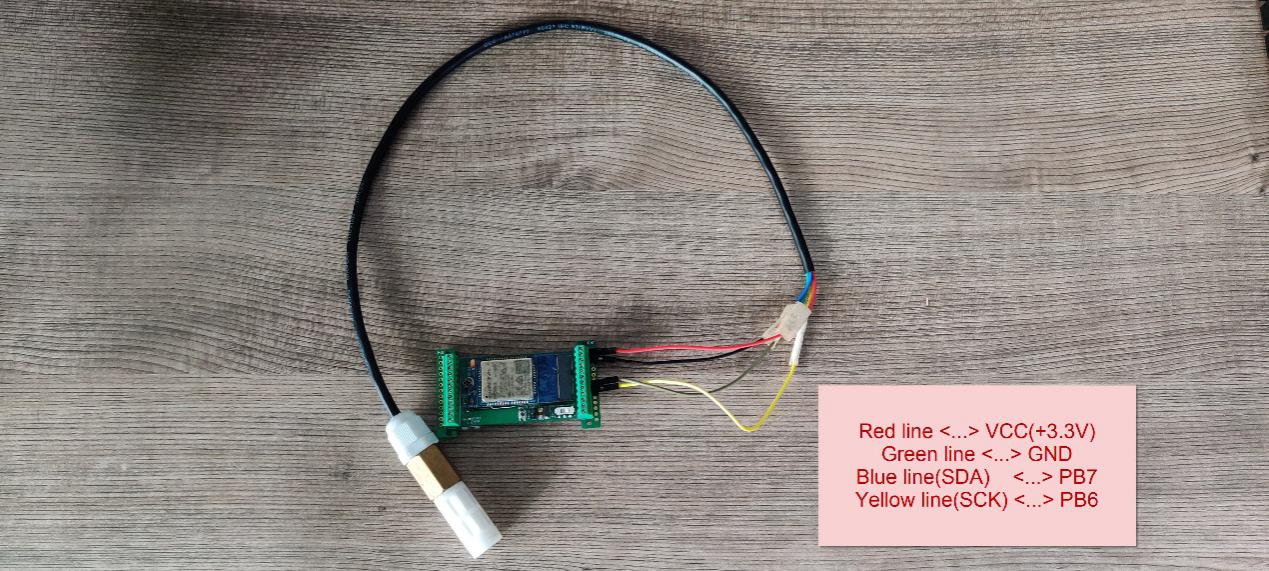
The device will be able to get the I2C sensor data now and upload to IoT Server.
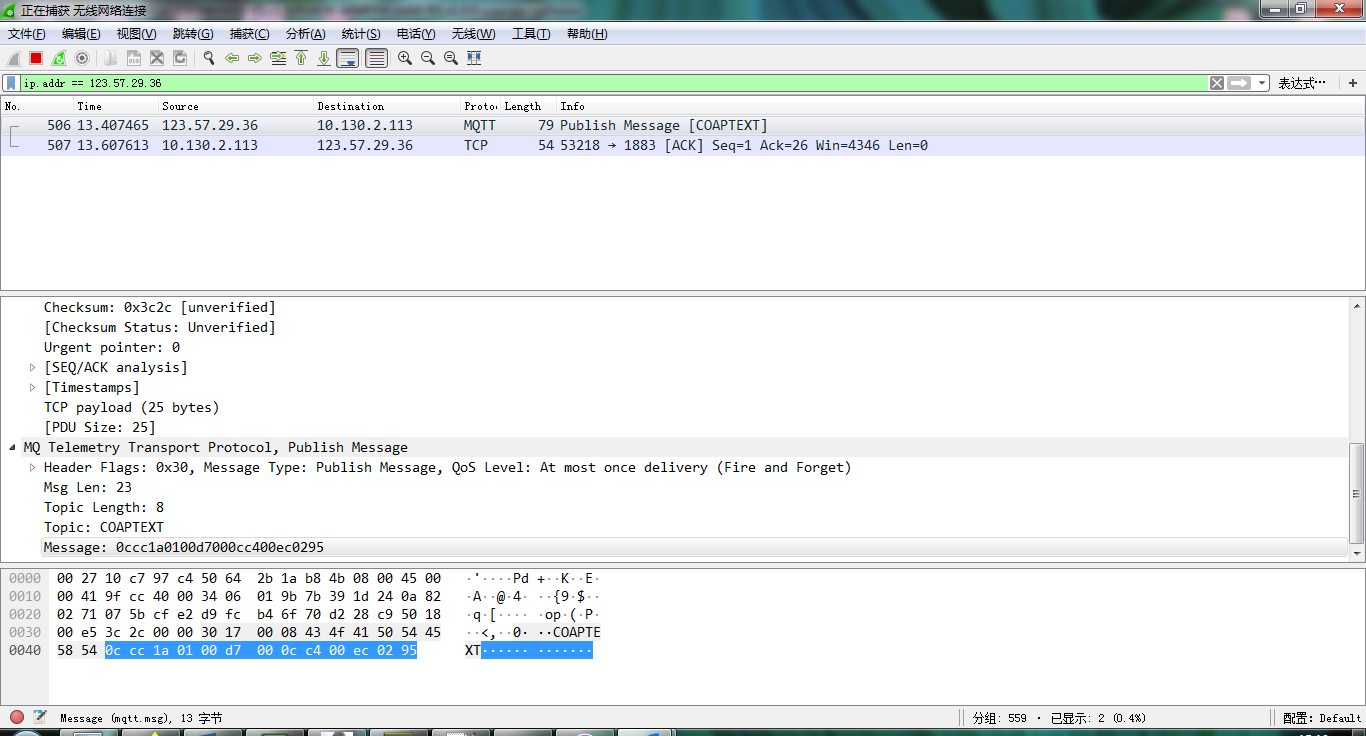
Convert the read byte to decimal and divide it by ten.
Example:
Temperature: Read:00ec (H) = 236(D) Value: 236 /10=23.6℃
Humidity: Read:0295(H)=661(D) Value: 661 / 10=66.1, So 66.1%
If you want to use other I2C device, please refer the SHT20 part source code as reference.
2.4.10 Distance Reading
Refer Ultrasonic Sensor section.
2.4.11 Ultrasonic Sensor
The NBSN95 firmware supports ultrasonic sensor (with AT+CFGMOD=2) such as SEN0208 from DF-Robot. This Fundamental Principles of this sensor can be found at this link: https://wiki.dfrobot.com/Weather_-_proof_Ultrasonic_Sensor_with_Separate_Probe_SKU___SEN0208
The NBSN95 detects the pulse width of the sensor and converts it to mm output. The accuracy will be within 1 centimeter. The usable range (the distance between the ultrasonic probe and the measured object) is between 24cm and 600cm.
The picture below shows the connection:
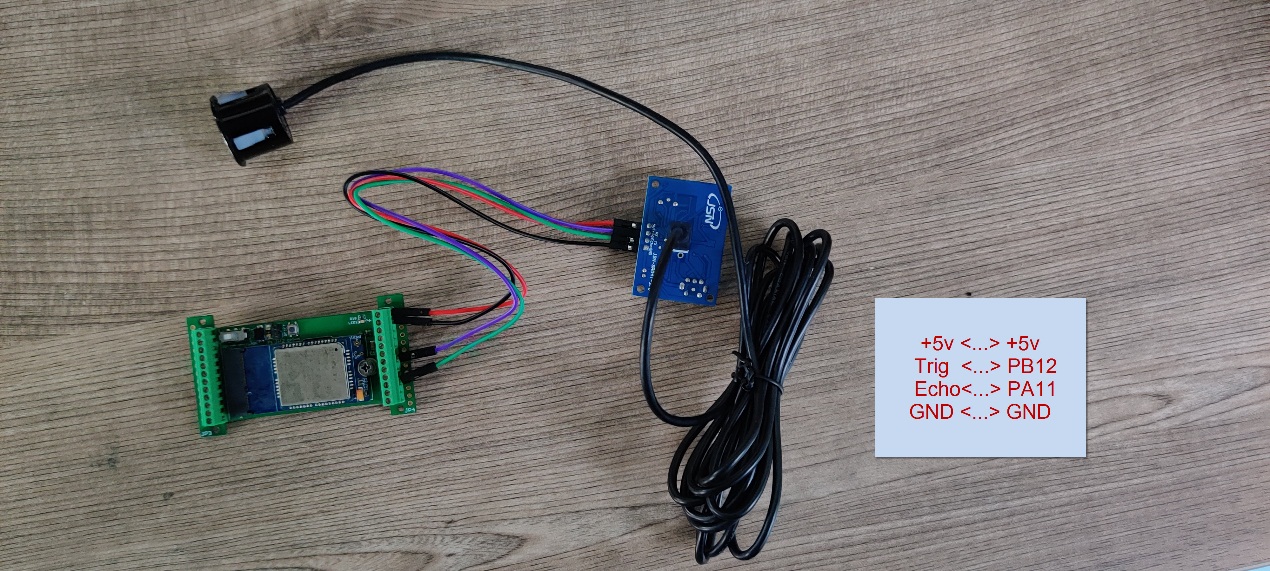
Connect to the NBSN95 and run AT+CFGMOD=2 to switch to ultrasonic mode (ULT).
Example:
Distance: Read:0155(Hex) = 3410(D) Value: 3410 mm=341.0 cm
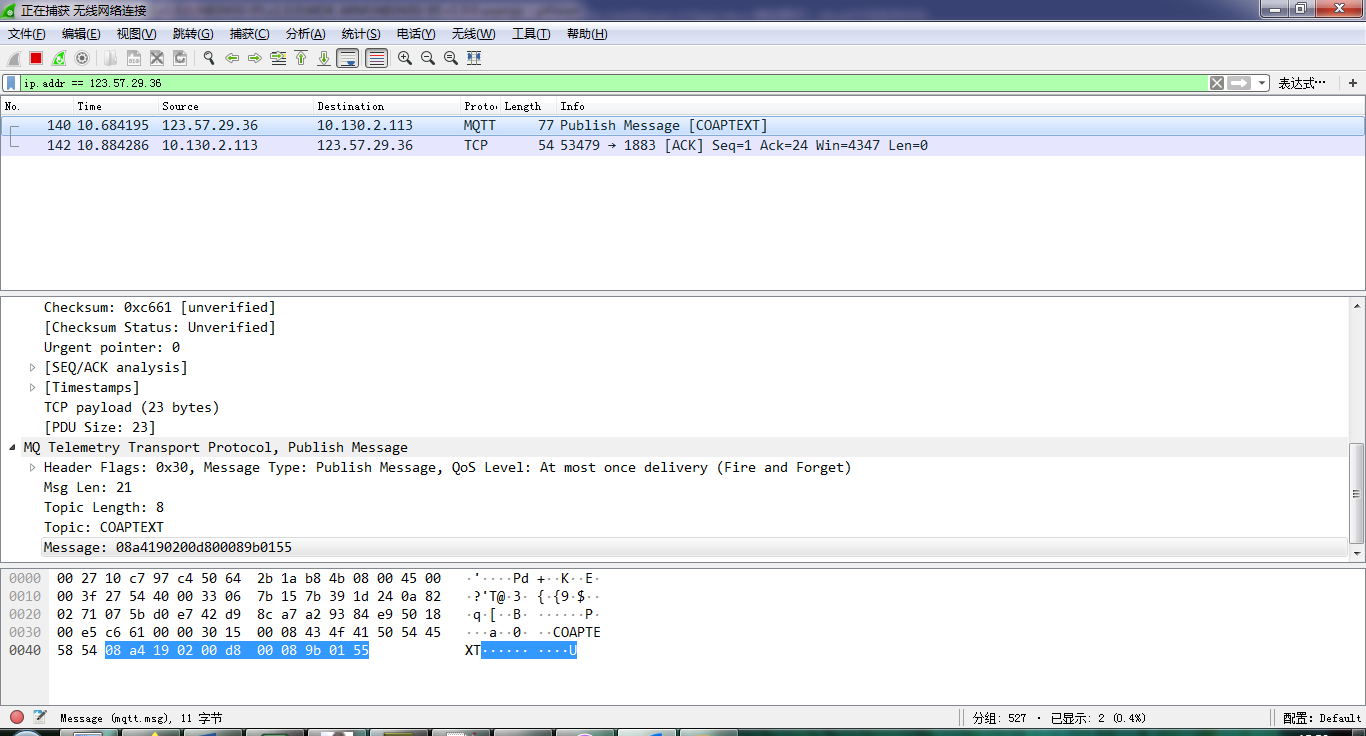
You can see the serial output in ULT mode as below:
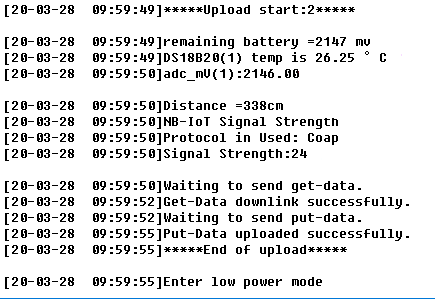
2.4.12 +5V Output
NBSN95 will enable +5V output before all sampling and disable the +5v after all sampling.
The 5V output time can be controlled by AT Command.
AT+5VT=1000
Means set 5V valid time to have 1000ms. So the real 5V output will actually have 1000ms + sampling time for other sensors.
2.5 Downlink Payload
By default, NSE01 prints the downlink payload to console port.

Examples:
Set TDC
If the payload=0100003C, it means set the END Node's TDC to 0x00003C=60(S), while type code is 01.
Payload: 01 00 00 1E TDC=30S
Payload: 01 00 00 3C TDC=60S
Reset
If payload = 0x04FF, it will reset the NSE01
- INTMOD
Downlink Payload: 06000003, Set AT+INTMOD=3
2.6 LED Indicator
The NSE01 has an internal LED which is to show the status of different state.
- When power on, NSE01 will detect if sensor probe is connected, if probe detected, LED will blink four times. (no blinks in this step is no probe)
- Then the LED will be on for 1 second means device is boot normally.
- After NSE01 join NB-IoT network. The LED will be ON for 3 seconds.
- For each uplink probe, LED will be on for 500ms.
2.7 Installation in Soil
Measurement the soil surface
Choose the proper measuring position. Avoid the probe to touch rocks or hard things. Split the surface soil according to the measured deep. Keep the measured as original density. Vertical insert the probe into the soil to be measured. Make sure not shake when inserting. https://img.alicdn.com/imgextra/i3/2005165265/O1CN010rj9Oh1olPsQxrdUK_!!2005165265.jpg
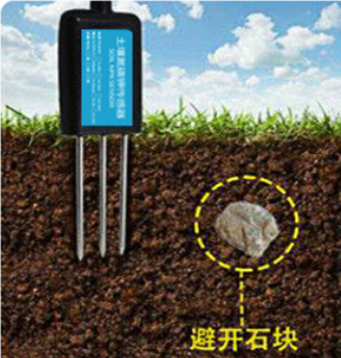
Dig a hole with diameter > 20CM.
Horizontal insert the probe to the soil and fill the hole for long term measurement.
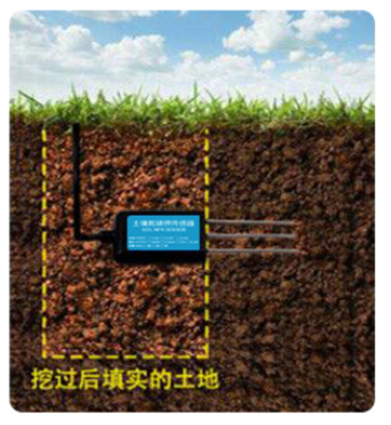
2.8 Firmware Change Log
Download URL & Firmware Change log
Upgrade Instruction: Upgrade_Firmware
2.9 Battery Analysis
2.9.1 Battery Type
The NSE01 battery is a combination of an 8500mAh Li/SOCI2 Battery and a Super Capacitor. The battery is none-rechargeable battery type with a low discharge rate (<2% per year). This type of battery is commonly used in IoT devices such as water meter.
The battery is designed to last for several years depends on the actually use environment and update interval.
The battery related documents as below:
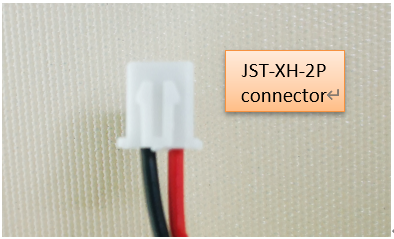
2.9.2 Power consumption Analyze
Dragino battery powered product are all runs in Low Power mode. We have an update battery calculator which base on the measurement of the real device. User can use this calculator to check the battery life and calculate the battery life if want to use different transmit interval.
Instruction to use as below:
Step 1: Downlink the up-to-date DRAGINO_Battery_Life_Prediction_Table.xlsx from: https://www.dragino.com/downloads/index.php?dir=LoRa_End_Node/Battery_Analyze/
Step 2: Open it and choose
Product Model
Uplink Interval
Working Mode
And the Life expectation in difference case will be shown on the right.

2.9.3 Battery Note
The Li-SICO battery is designed for small current / long period application. It is not good to use a high current, short period transmit method. The recommended minimum period for use of this battery is 5 minutes. If you use a shorter period time to transmit LoRa, then the battery life may be decreased.
2.9.4 Replace the battery
The default battery pack of NSE01 includes a ER26500 plus super capacitor. If user can't find this pack locally, they can find ER26500 or equivalence without the SPC1520 capacitor, which will also work in most case. The SPC can enlarge the battery life for high frequency use (update period below 5 minutes).
3. Access NB-IoT Module
Users can directly access the AT command set of the NB-IoT module.
The AT Command set can refer the BC35-G NB-IoT Module AT Command: https://www.dragino.com/downloads/index.php?dir=datasheet/other_vendors/BC35-G/
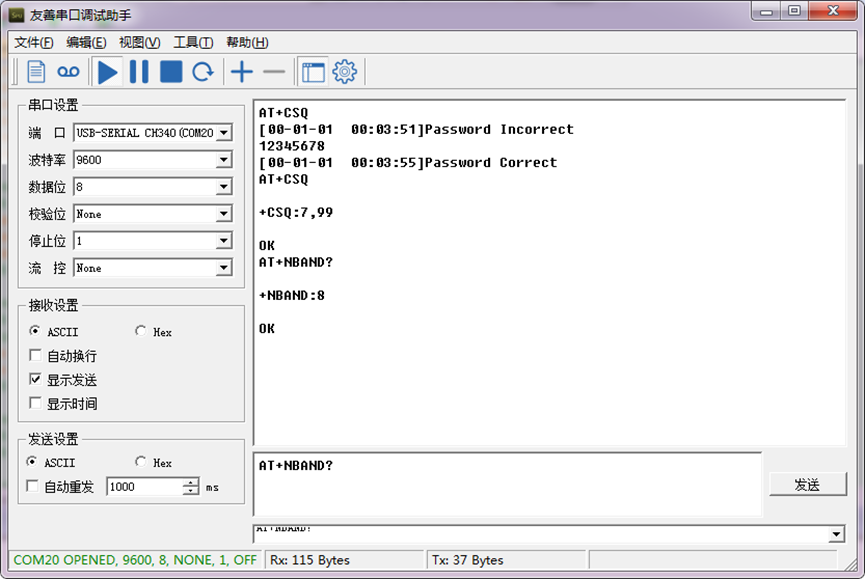
4. Using the AT Commands
4.1 Access AT Commands
See this link for detail: https://www.dragino.com/downloads/index.php?dir=NB-IoT/NSE01/
AT+<CMD>? : Help on <CMD>
AT+<CMD> : Run <CMD>
AT+<CMD>=<value> : Set the value
AT+<CMD>=? : Get the value
General Commands
AT : Attention
AT? : Short Help
ATZ : MCU Reset
AT+TDC : Application Data Transmission Interval
AT+CFG : Print all configurations
AT+CFGMOD : Working mode selection
AT+INTMOD : Set the trigger interrupt mode
AT+5VT : Set extend the time of 5V power
AT+PRO : Choose agreement
AT+WEIGRE : Get weight or set weight to 0
AT+WEIGAP : Get or Set the GapValue of weight
AT+RXDL : Extend the sending and receiving time
AT+CNTFAC : Get or set counting parameters
AT+SERVADDR : Server Address
COAP Management
AT+URI : Resource parameters
UDP Management
AT+CFM : Upload confirmation mode (only valid for UDP)
MQTT Management
AT+CLIENT : Get or Set MQTT client
AT+UNAME : Get or Set MQTT Username
AT+PWD : Get or Set MQTT password
AT+PUBTOPIC : Get or Set MQTT publish topic
AT+SUBTOPIC : Get or Set MQTT subscription topic
Information
AT+FDR : Factory Data Reset
AT+PWORD : Serial Access Password
5. FAQ
5.1 How to Upgrade Firmware
User can upgrade the firmware for 1) bug fix, 2) new feature release.
Please see this link for how to upgrade: http://wiki.dragino.com/xwiki/bin/view/Main/Firmware%20Upgrade%20Instruction%20for%20STM32%20base%20products/#H2.HardwareUpgradeMethodSupportList
Notice, NSE01 and LSE01 share the same mother board. They use the same connection and method to update.
5.2 Can I calibrate NSE01 to different soil types?
NSE01 is calibrated for saline-alkali soil and loamy soil. If users want to use it for other soil, they can calibrate the value in the IoT platform base on the value measured by saline-alkali soil and loamy soil. The formula can be found at this link.
6. Trouble Shooting
6.1 Connection problem when uploading firmware
6.2 AT Command input doesn't work
In the case if user can see the console output but can't type input to the device. Please check if you already include the ENTER while sending out the command. Some serial tool doesn't send ENTER while press the send key, user need to add ENTER in their string.
7. Order Info
Part Number: NSE01
8. Packing Info
Package Includes:
- NSE01 NB-IoT Soil Moisture & EC Sensor x 1
- External antenna x 1
Dimension and weight:
- Size: 195 x 125 x 55 mm
- Weight: 420g
9. Support
- Support is provided Monday to Friday, from 09:00 to 18:00 GMT+8. Due to different timezones we cannot offer live support. However, your questions will be answered as soon as possible in the before-mentioned schedule.
- Provide as much information as possible regarding your enquiry (product models, accurately describe your problem and steps to replicate it etc) and send a mail to support@dragino.com